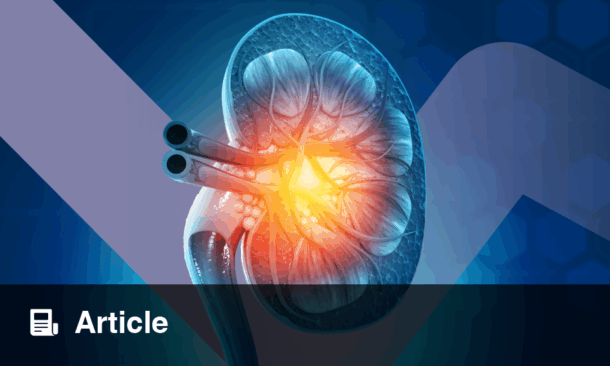BERLIN, the modern architectural capital city of Germany hosted this year’s ERA-EDTA Congress that took place on 5-8th June 2021. Albert Einstein, one of the greatest theoretical physicists in history, lived and carried out his experimental work in Berlin, Germany for 22 years. It was during his time in this city that he was awarded the Nobel Prize in physics in 1922. It comes as no surprise that the municipality has attracted so many more scientific researchers and associations, each one attempting to soak in the aura of one of the most prominent minds in history.
Global challenges of the COVID-19 pandemic meant that not everyone was able to attend the ERA-EDTA Congress 2021 in person. However, a select few vaccinated nephrologists were able to make the occasion. The momentum of the 58th meeting was unstirred, as this is the second virtual meeting hosted by the society. The ERA-EDTA President Christoph Wanner, in the opening ceremony, assured the participants that the society was adapting to the changing times of working and networking remotely, it was a real renewal process, refurbished, resilient, and stronger than ever before.
The benefits of a virtual hybrid congress were clear to all the attendees and presenters as they gathered in their homes, offices, and even laboratories to observe the online platform come to life. Over 5,207 attendees were spoiled for choice with 1,159 speakers who presented 107 sessions, 1,056 mini-orals, 58 sponsors and exhibitors, and Center for Executive and Professional Development (CEPD) courses. The Congress President, Markus Ketteler, Head of Division of Nephrology, University Hospital Würzburg, Germany, during the opening ceremony took the opportunity to thank the Scientific Committee Chair Giovambattista Capasso, Director Department of Translational Medical Sciences, University Luigi Vanvitelli Naples, Italy who laboured tirelessly to provide the innovative ground-breaking science programme. With over 2,000 high-quality abstracts submitted and 1,191 accepted this year, Ketteler acknowledged Maria José Soler Romeo, Chair of the Paper Selection Committee, Giuseppe Palladino, ERA-EDTA Research and Development Manager, researchers and dedicated volunteers and researchers for their contributions, implementation, collaboration, and submissions for the engendered execution of a successful ERA-EDTA meeting.
The culture of mechanistic thinking is shared by many nephrologists due to the in-depth physiology of the kidneys, heart, and even the brain. With emerging rare kidney diseases, education is key to stay up to date with recent developments within the field. On the first day of the congress, several educational topics were covered: hypertension, diabetes and cardiovascular diseases in chronic kidney disease, recurrent glomerulonephritis following renal transplantation, nephropathology of COVID-19, and so much more. Wanner encouraged nephrologists to expand their expertise and broaden their knowledge in various aspects of internal medicine, especially the next generation of doctors.
Appreciation is a key motivator, and in ERA-EDTA honorary awards were distributed as an acknowledgement for service by society Wanner. The first two awards were presented to the 2021 Congress President Ketteler, as recognition for his professionalism in the organisation of this year’s virtual congress, and Capasso, Scientific Committee Chair, for his service in the society for the past 2 years and collating the scientific programme of this congress. Additionally, other awards were presented covering three categories: David Jayne, University of Cambridge, UK for outstanding clinical contributions to nephrology; Juan Jesus Carrero, Department of Epidemiology, Karolinska Institutet, Solna, Sweden for research excellence in nephrology; and Thimoteus Speer, Translational Cardio-Renal Medicine, Saarland University Hospital, Homburg, Germany, who received the Stanley Shaldon award for young investigators.
It was clear that climate change and its effects on health was a hot topic in this year’s congress. During the Welcome Ceremony, a lecture was presented by Carlo Barbante, Director of the Institute of Polar Sciences, Ca’Foscari University of Venice, Italy, who discussed climate change, global warming, and the environmental impact of these changes in the present and future projections. In this issue of EMJ Nephrology, our team covered a session review of climate change and nephrology and a selection of other topics from the ERA-EDTA Congress, aiming to impart some of the knowledge shared at the congress.
Networking and building rapports are essential within the nephrology community, where researchers and professionals with different specialisations in nephrology can meet face to face to share ideas and information on the latest research and knowledge. “See you in Paris in 2022 for the 59th ERA-EDTA meeting,” President Wanner, shared.
‘Healthy Environment, Healthy Kidneys’: The ERA-EDTA Position on Climate Change and Health
CLIMATE change poses one of the most significant risks to human health, with 24% of deaths worldwide attributable to environmental factors. The burden of addressing the mortality and morbidity associated with climate change, such as undernutrition, mental disorders, and noncommunicable diseases (e.g., chronic kidney disease and acute kidney injury), falls to nephrologists and other healthcare professionals. Despite this, the healthcare sector is believed to produce 4.4% of the global carbon footprint, greatly exacerbating the climate emergency.
Therefore, ‘Healthy Environment, Healthy Kidneys’ was chosen as the theme for this year’s ERA-EDTA Virtual Congress, 5th–8th June 2021. This highlighted the vital role played by healthcare professionals in advocating for international efforts to reduce greenhouse gas emissions and protect against future global warming.
According to ERA-EDTA President Christopher Wanner: “The ERA-EDTA was one of the first international medical societies to urge investment in the transformation to a greener healthcare. The theme of this year’s fully virtual Congress, Healthy Environment, Healthy Kidneys, underlines the ERA-EDTA’s commitment and the important role of nephrologists in addressing climate change.”
On Day 3 of the ERA-EDTA Congress, a symposium titled ‘Climate change and health: the opinion of the younger generation’ provided an opportunity for younger healthcare professionals to share their views on climate change and health. Martin Herrmann and Sylvia Hartmann, President and Vice Chair of the German Alliance for Climate Change and Health, respectively, were two of the speakers. Herrmann discussed the threat of climate change to the public health achievements of the last century, and noted that there is a major opportunity in addressing climate change, since climate protection strategies are linked with substantial health benefits. Similarly, Hartmann considered the perspectives of the coming medical generation on the climate crisis. Beyond daily medical routines, healthcare professionals have a unique responsibility to demonstrate the health emergency caused by climate change.
Warner concluded: “Throughout the world younger people are in the vanguard of action against global warming, and have shown us that addressing climate change is everyone’s responsibility.”
COVID-19 Causing Long-Lasting Renal Problems?
CONCERNING evidence has emerged from on ERA-EDTA 2021 that took place on 5–8th June, describing molecular tissue damage caused by the novel coronavirus leading to long-lasting kidney issues. This information has spurred nephrologists to stress the importance of aftercare following COVID-19 infection, and acknowledge the strong predictive potential for severity which lies with using kidney values early in the course of disease onset.
Associated nephritis has been identified as an early warning signal for serious courses of the virus, and at ERA-EDTA the findings were presented from study by Oliver Gross, who led a research team to investigate prediction strategies. Crucially, kidney involvement with the virus is an important risk factor for mortality; early complications such as proteinuria, hypoproteinemia and anti-thrombin III deficiency are described as having prognostic potential, building on prior knowledge that acute kidney injury (AKI) was contributing to this relationship.
Two hundred and twenty-three patients were included, with 145 used as a predictive cohort; utilising test strips to indicate early urinary changes and therefore a more severe COVID-19 course, study endpoints were ICU admission or mortality. Gross explained at the opening press conference for ERA-EDTA, “kidney values are a seismograph for the course of COVID-19 disease,” talking about combining urine and serum markers as a predictive system.
Other studies were mentioned, and support the association with kidney involvement, concluding dramatically worsened outcomes of viral disease and increased mortality. A Chinese study found 1.25% of patients died without kidney involvement, compared with 11.2% mortality in those with.
Questions raised surround the specific long-term impacts expected after COVID-19, particularly when many patients never recover kidney function, and instead see gradual deterioration over the course of the disease. “The kidney must be at the centre of COVID-19 aftercare,” was the statement Gross gave, going on to mention, “early treatment can halt the loss of kidney function.” He delivered an important conclusion, which will focus clinical action; “Given that kidney disease does not produce symptoms until very late, we would like to make people who have had COVID-19 disease aware of the possibility of long-term consequences on the kidneys. It’s important that general practitioners check their patients’ kidney values (GFR, albuminuria) on a regular basis.”.
Iptacopan an Exciting Alternative Treatment for IgA Nephropathy
HINDERING the lives of countless teens, IGA nephropathy (IgAN) is a chronic kidney disease and leading cause of transplantation. A study presented on June 6th at ERA-EDTA 2021 revealed promising data in form of a Phase II study of iptacopan; an oral inhibitory approach to therapy for IgAN without the side effects of immunosuppression.
IgAN exists as the most common form of glomerulonephritis (GN), previously treated with immunosuppressive therapy; aiming to combat a complex inflammatory response causing progressive loss of kidney function. Evidence has categorised this method with increased incidence of adverse effects, especially infections, and led to criticism amongst experts. In this way, a niche exists for targeted therapy.
As a highly selective inhibitor, iptacopan can be applied to target chronic inflammation by blocking the alternative complement signalling pathway of the immune system. Investigations took form in a randomised double-blind placebo-controlled clinical trial, where 112 patients were evaluated in two stages. 46 IgAN patients were given three different doses iptacopan or placebo for 90 days, and then a further 66 four doses or placebo for 180 days; the endpoint being a dose-response relationship improving proteinuria.
All patient data was later evaluated combined, with secondary endpoints safety and tolerability, as well as estimated glomerular filtration rate and biomarkers of the alternative complement signalling pathway. Five groups of varying iptacopan dosage and placebo were compared, with four patients discontinuing treatment from side effects. Analysis presented a statistically significant dose-response effect against the placebo, a trend to stabilisation in renal function, and improved biomarkers. Side-effects were mild with no serious adverse effects, most commonly headache at 11.6%, with back-pain, diarrhoea, and vomiting all 6.3% and unrelated to dose taken.
Success of the trial is witnessed in progression to Phase III trials, Barratt who headed investigations summarised, “This is the first study to report the safety and efficacy of targeted alternative complement pathway inhibition in IgAN patients, with the results showing a significant dose-dependent reduction in proteinuria and a trend to eGFR stabilisation.”
Understanding the Association between COVID-19 and Acute Kidney Injury
ACUTE kidney injury (AKI) in patients diagnosed with COVID-19 is on the rise, despite the fact that role of SARS-CoV-2 infection in the kidneys is not fully understood. At the early stages of COVID-19 pandemic, it was discovered that coronavirus caused a wide range of symptoms, along with the expected respiratory symptoms, diagnosed patients also had neurological, gastrointestinal, renal, and many more associated symptoms. These findings brought about the belief and understanding that COVID-19 virus may potentially be a multi-system disease and affects several organs directly.
Authorities in Hamburg, Germany, in the spring of 2020, ordered autopsies to be executed on all the patients who had died from COVID-19. By this, they were able to collate the world’s biggest autopsy database containing all organ systems. This post-mortem data collection was carried by forensic pathologists and has contributed to several organ-related COVID-19 primary research studies.
Tobias Huber, UKE Hamburg, Germany, discussed some of his research findings at opening ceremony of the ERA-EDTA Congress that took place on the 5th June 2021. COVID-19 patients have an elevated rate of AKI (56.9%) compared to other patients diagnosed with serious infections or sepsis (37.2%) in the intensive care unit. Additionally, 4.9% of COVID-19 diagnosed patients require a renal replacement therapy in comparison with 1.6% of patients diagnosed with other severe infections. A remarkable previous research led by Huber, showed that the COVID-19 virus load in a deceased patient was highest in the respiratory tract and second highest in the kidneys, followed by lower levels in other organs such as heart, liver, and brain.
An alternative autopsy study, with similar high comorbidity rate as in other studies, carried out by Huber and his team aimed to understand the correlation between renal tropism and outcome of COVID-19. Sixty-three autopsies were carried out and results showed that SARS-CoV-2 infection was identified directly, in 60% of the cases, in the kidneys. Furthermore, the results showed period of time between the diagnosis of COVID-19 and death was shorter when the virus was detected in the kidneys compared to absence virus in the kidneys, 14 days versus 21 respectively.
These studies and many more have associated COVID-19 with AKI, and identified it as multi-system disease, and have set a steppingstone potentially understanding why kidney injury is recurrent in patients diagnosed with COVID-19.
Targeted Therapy Could Be Key to C3 Glomerulopathy Progression
ACCUMULATION of C3 protein in the glomeruli causes a rare immunological disease, C3 glomerulopathy (C3G). This deposition of the C3 protein causes severe inflammation of the glomeruli and renal dysfunction, progressing to final stage of kidney disease where diagnosed patients require dialysis and possibly a kidney transplant after 10 years. There is currently no approved treatment for C3G, however, a new study illustrated that blocking the inflammatory C5a receptor with avacopan, could be an effective method of slowing the progression of C3G.
The Controlled Trial Evaluating Avacopan in C3 Glomerulopathy (ACCOLADE) study was presented at the ERA-EDTA congress that took place in 5–8th June 2021. Currently C3G is treated by lowering of both blood pressure and proteinuria, and by use of non-specific immunosuppression. For the future purpose of comparing different therapeutic methodologies, a ‘European Register for C3 glomerulopathy and immune-complex-mediated MPGN’, in which cases are consistently recorded, was launched in 2015.
The ACCOLADE study conducted a randomised, double-blind, placebo-controlled analysis of the use of avacopan in patients diagnosed with C3G over a period of 26 weeks. The participants received either 30 mg of avacopan twice daily (n=28), or placebo (n=29), both administered orally. A C3G Histologic Index (C3HI ‘Disease Activity Score’) was utilised to calculate changes in histology throughout the study. The higher values of the C3G histologic index suggested severe disease progression. Remarkably, at 26 weeks, the C3HI activity score improved by 0.2% in the avacopan group but exacerbated by 20.6% in the placebo group. The C3HI chronicity score increased by 31.7% in the avacopan group and by 57.5% in the placebo, equating to a total change of 0.8 versus 1.6, respectively. Additionally, proteinuria result levels, also included in the ACCOLADE study, displayed notable improvement in the group of patients using avacopan.
Preclinical studies indicate that C3G disease progression is noticeably decelerated by avacopan, a selective C5a receptor inhibitor. “In patients with C3 glomerulopathy, targeted therapy aimed at the complement system provides the best possible route to slow disease progression,” explained Bomback. “In addition, the more selectively we target the causal disease mechanisms in the immune system, as was done in this study at the C5a receptor with avacopan, the less the immune system as a whole is suppressed, which should also yield not only more effective but also less toxic therapies.’
Mechanisms of Kidney Protection by Gliflozins
GLIFLOZINS, or SGLT2 inhibitors, are oral anti-diabetic drugs that reduce blood sugar and improve cardiovascular and renal outcomes in patients with or without diabetes. A recent study has shown SGLT2 inhibitors slow the progression of chronic kidney disease (CKD) via correlations with the individual’s haematocrit value regardless of their diabetes status. The results of this new study were presented as part of a press release at ERA-EDTA.
The EMPA-REG OUTCOME study by Christoph Wanner, University of Würzburg, Germany, showed the wider benefits of SGLT2 inhibitors extending beyond the known effects of lowering blood sugar and that the rate of cardiovascular events in patients with type 2 diabetes is significantly reduced if the SGLT2 inhibitor empagliflozin is administered.
The mechanisms by which SGLT2 inhibitors produce their renoprotective effect are still largely unknown. The study group carried out a post-hoc analysis using data from the EMPA-REG OUTCOME study to identify potential factors that could mediate or be correlated with the renoprotective effects of SGLT2 inhibitors. The pooled treatment group (empagliflozin 10 and 25 mg/day) was compared with the placebo group. From different physiological areas, 17 different potential factors were registered at the start of the study and statistically evaluated on a time-dependent basis and at Week 12 for orientation point analysis. The variables were incrementally summed according to the strength of their effect on the composite renal endpoint.
In more advanced CKD stages, the kidneys no longer produce sufficient amounts of erythropoietin, and the patient may be diagnosed with renal anaemia measured by reduced haematocrit levels. After adjusting the haematocrit value over time, the study group found the haematocrit was the strongest mediator of renoprotective effects. Other factors included serum uric acid concentration, albuminuria, HbA1c, blood pressure, and fatty acid levels.
“We know that severe anaemia is a predictor not only for CKD progression, but also for cardiovascular events,” explained Wanner. “According to the new study data, haematocrit is the most important mediator of the positive gliflozin effects, i.e., the main mechanism by which the SGLT2 inhibitors stabilise renal function and improve the clinical outcome correlates with the percentage increase in erythrocytes.”
Lung Sonography Could Be Useful in Identifying Lung Decongestion in Patients Undergoing Haemodialysis
LUNG congestion, a condition whereby water accumulates within the lungs, is common in patients who are undergoing haemodialysis especially in those that have a high risk of developing cardiovascular disease such as coronary heart disease or heart failure. X-ray imaging is the current preferred method used to identify this congestion, compared to a stethoscope. Progression of the lung congestion severely impairs and compromises the pulmonary gas exchange leading to shortness of breath and, in some cases, death.
Patients undergoing haemodialysis have higher mortality rate correlating to lung congestion, as all the fluid presented during dialysis session is retained. However, the severity of overhydration and lung congestion can be analysed by sonography, a type of ultrasound imaging. An international, multicentre study assessing this ultrasound methodology was presented in the ERA-EDTA Congress on 6th June 2021. The study, involving 363 patients, used mortality, heart attack and decompensated heart failure as primary endpoints to assess the patient outcomes.
The study was divided in two groups, in the first group the ultrasound was carried out by unblinded nephrologists who knew that patients were going through dialysis treatments, whilst the control group was carried out by blinded cardiologists who had no knowledge of treatment. The parameters of measurement within the study were B-lines in the ultrasound image which displayed fluid accumulation within the lung tissue. Haemodialysis management target required was less than 15 B-lines.
The results of the study showed that the number of B-lines reduced from 15 to nine from the start to the end of the study sonography group (n=183). However, in the control group (n=180) the number substantially increased from 16–30. Additionally, 117 patients in the sonograph group (78%) reached the target value (<15 B-lines). “The lung ultrasound-guided treatment strategy significantly reduced individual secondary, post hoc endpoints: decompensations of heart failure occurred 63% less frequently and severe cardiovascular events 37% less frequently,” concluded Claudio Torino, Clinical Epidemiology and Physiopathology of Renal Diseases and Hypertension of Reggio Calabria, National Council of Research, Institute of Clinical Physiology, Reggio Calabria, Italy.
Dapagliflozin Provides Protection Against Focal Segmental Glomerulosclerosis
EMPLOYING dapagliflozin treatment has provided favourable renal outcomes in patients of chronic kidney disease (CKD). This SGLT-2 (sodium dependent glucose co-transporter) inhibitor was assessed through the DAPA-CKD study, and the significant benefits to patients with FSGC (focal segmental glomerulosclerosis) discussed on 6th June ERA-EDTA 2021.
In a treatment path frequently resulting in dialysis, demand exists for a new approach to stabilise and protect kidney function; this SGLT-2 inhibitor was investigated as an alternative to glucocorticoids and supportive therapy, with study led by David Wheeler, Professor at University College London. Findings concluded that dapagliflozin markedly reduces risk of progressive loss in renal function for patients of CKD, both in the presence and absence of diabetes mellitus.
Success of the inhibitor stems from its action in the proximal renal tubule, to increase urinary glucose excretion. This was analysed among 115 participants with FSGS, randomised to receive 10 mg or placebo on top of standard treatment. The combined primary endpoint included a 50% decrease in glomerular filtration rate (eGFR), dialysis requirement or cardiovascular death.
Tolerability and safety profiles for dapagliflozin were good, with similar discontinuations in both groups. 4 (7.5%) of the treated patients and 9 (14.5%) on placebo reached the primary endpoint, with comparative annual eGFR loss -1.9ml/min/1.73m2 in the dapagliflozin versus -4.2 ml/min/1.73m2.
Results from similar studies present SGLT-2 inhibitors helpful at improving cardiovascular and kidney outcomes with patients of type 2 diabetes, but this study extends findings to patients who do not have diabetes. This was explained at ERA-EDTA by Wheeler, “SGLT2 inhibitors offer a promising new therapeutic option in the field of nephrology and are likely to be used more extensively in future, both in diabetic and non-diabetic kidney diseases. Not only do these agents slow progression of kidney disease, but they also reduce the risk of cardiovascular diseases, which are important comorbidities in this patient population.”
Critics will acknowledge the study size and demographic, such as average age 53±13.9 years, and warrant widening the sample to carry the promising results with greater scientific weight.







